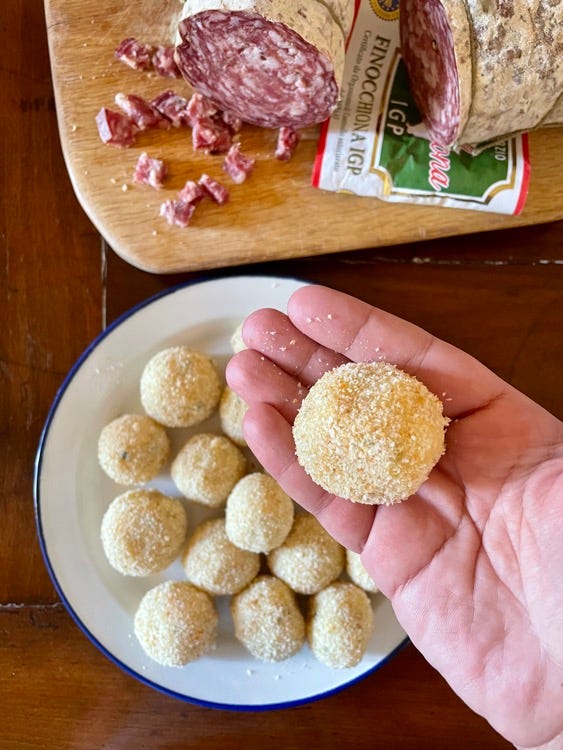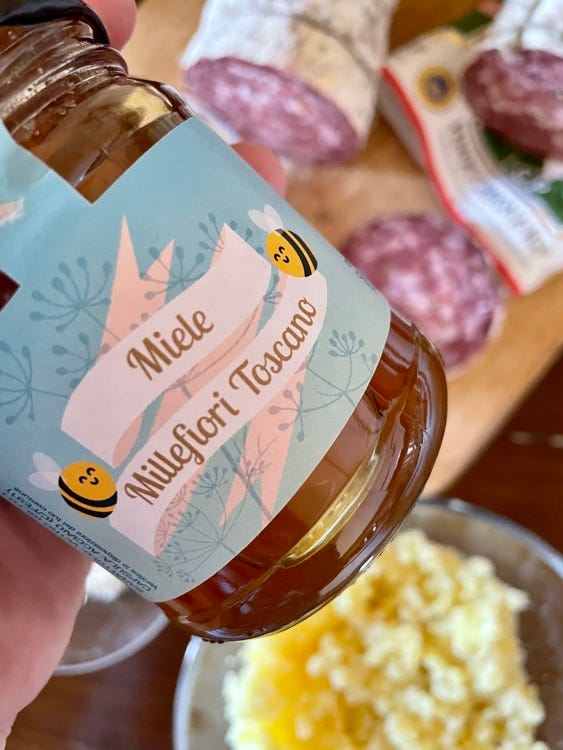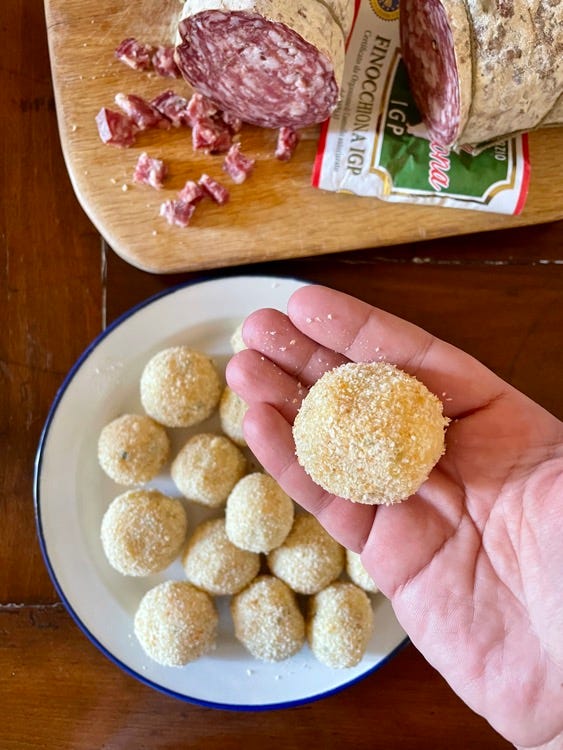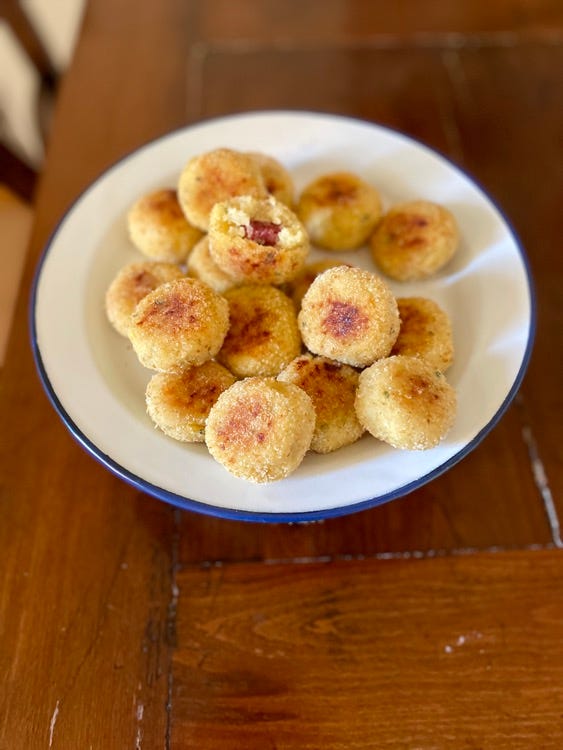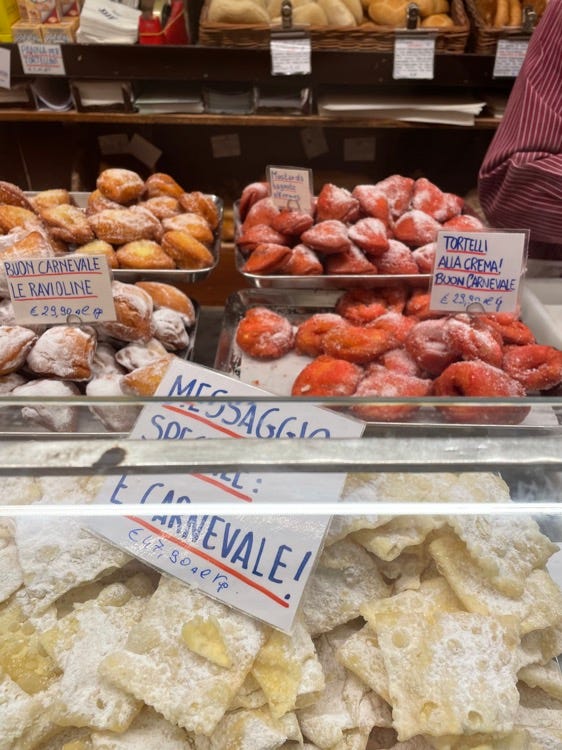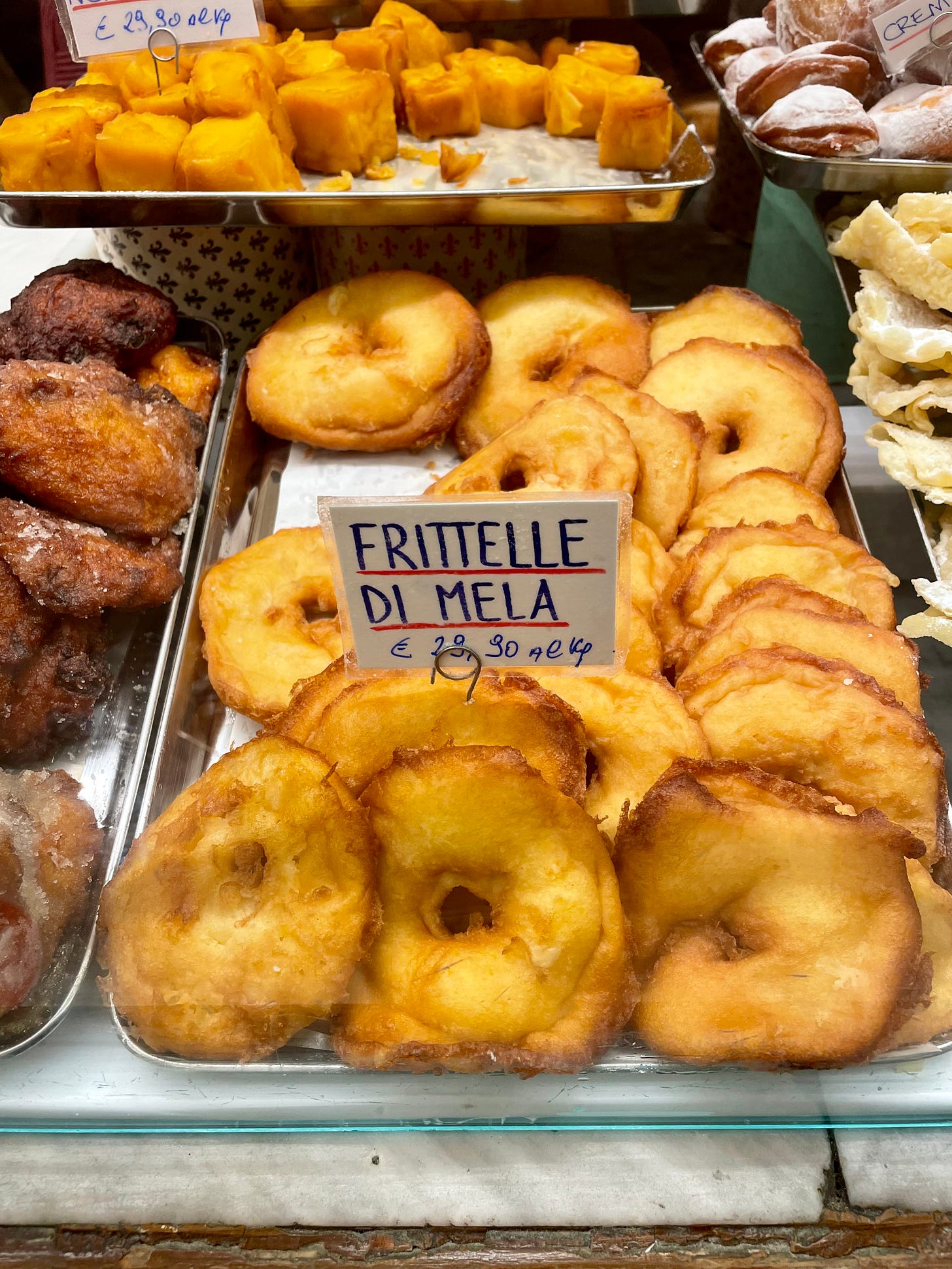In February, if the days be clear, /The waking bee, still drowsy on the wing.
Will guess the opening of another year. /And blunder out to seek another spring.
Crashing through winter sunlight's pallid gold, /His clumsiness sets catkins on the willow. / Ashake like lambs' tails in the early fold, /Dusting with pollen all his brown and yellow, /But when the rimy afternoon turns cold /And undern squalls buffet the chilly fellow, / He'll seek the hive's warm waxen welcoming / And set about the chambers' classic mould.
The Land, Victoria Sackville-West
If you enjoy my newsletter, share it with your friends and family or on social media. It would help me so much to get discovered by other food-lover people.
Grazie, Monica
And now, buona lettura!
About meatballs
Meatballs are a typical preparation of Italian home cooking.
It is a true gastronomic heritage consisting of Italian, regional, super local, and family recipes.
Claiming to have grown up on “bread and meatballs”, using a typical Italian expression, I would not lie. Nonna had an impressive repertoire of polpette and cooked them often.
There were traditional ones, prepared with a mix of minced meat and sometimes just pork. But I also remember a long list of meatless meatball recipes: herbs and ricotta, fish, and vegetable balls. Not to say the numerous versions born out of recycling.
Over the years, I have developed several meatball recipes. For example, my friends loved the lemon rice polpette. They are surprisingly easy to make and tasty. I serve them with a coconut tomato sauce. But I also enjoyed the eggplant meatballs.
A few ingredients and the aubergine is the absolute protagonist.
And like grandma used to, I cook meatballs in four different ways.
Classic, fried. Sometimes I prefer to brown slowly polpette in a pan with olive oil.
Lastly, I often boil my balls in broth or water. And, of course, roast them in the oven.
Preparation is a ritual
I fasten my apron and arrange what I need on the kitchen table.
In a bowl, I combine and mix, one by one, the ingredients.
At first, I mix with a fork or spoon, then with my hands. Finally, I shape the meatballs, which I model between the palms of my hands.
One by one, I place them on a plate or tray, waiting to cook them.
Today I'd like to tell you about a new recipe in my repertoire and what bees have to do with it.
About bees and meatballs.
My Tuscan meatballs
I developed a new meatball recipe.
I called them Tuscan meatballs, and I chose this name because the ingredients include Finocchiona PGI, Tuscan excellence.
If you don't know it, it has an unmistakable flavor and aroma: that of seeds and flower fennel. And since I was born and raised in Emilia-Romagna, I think I can say I know a little about cured meats.
As a journalist and food writer, I often write about great Italian products and producers.
A few months ago, the Finocchiona PGI Consortium emailed me about a new environmental sustainability project involving the consortium's member producers that I would like to share with you.
They have adopted an entire apiary by placing beehives in fields dedicated to growing fennel.
I love this kind of agriculture, pro-biodiversity. I hope others will soon choose to support such visionary projects.
For that reason, I created a meatball where the heart is a little cube of PGI Finocchiona. Of course, I also added a tablespoon of honey to the mixture.
If you have vegetarian family members or relatives, replace the heart of Finocchiona PGI with a cheese cube.
Tuscan meatballs recipe
about 15 meatballs
List of the Ingredients
300 g boiled mashed potatoes
100 g cannellini beans
30 g grated Parmigiano Reggiano
20 g breadcrumbs + 30 g
egg, 1
100 g Finocchiona PGI, cut into small cubes
chopped parsley and oregano, fresh or dried, to taste
salt to taste
optional: 1 tablespoon of honey to add to the mixture
Method
Boil cannellini beans until soft in water with some sage and bay leaves.
Then drain, remove the herbs, and mash your beans with a fork.
In a bowl, stir grated Parmigiano, 20 g of bread crumbs, herbs, and salt.
Add boiled and mashed potatoes and beans and egg. Stir with a spoon.
Take a generous spoonful of the mixture and one little cube of Finocchiona PGI, and close it inside the meatball.
Dust the meatballs with bread crumbs.
Line a large baking sheet with baking paper, grease the bottom with olive oil, arrange the meatballs, and bake in a preheated oven at 190C degrees for about 20-25 or until they reach the browning you like.
Halfway through cooking, turn them and add olive oil if necessary.
Buon appetito!
An old Carnival story of Bologna.
Mr. Persuttino Gambuzzi
Persuttino, in the Bolognese dialect, means little ham. Gambuzzi is an allusion to gambuccio, the end part of the ham.
Mr. Gambuzzi is a forgotten mask of the Bolognese Carnival.
The mask was born in 1847 from the imagination of artisan framer Leonardo Scorzoni.
It is a cold and foggy evening when Scorzoni visits his friend Onofri, a master puppeteer. To contrast the cold, he accepts a few glasses of wine on the way.
He is tipsy that night when he arrives at the San Gregorio theater, where a puppet performance is in progress.
Scorzoni takes a wooden head from the puppet basket and improvises a performance.
He achieves great success. And Onofri asks him to participate in the following shows as well.
After a year, Scorzoni becomes an actor playing Persuttino Gambuzzi.
The character wears a yellow floral cloak, green breeches tied at the knee, a red bodice, white stockings, and a floppy hat, also green in color. A fake mole and eyebrows artfully made up to look huge. A dark wig styled in a ponytail completes the look.
Persuttino knows how to make people laugh.
But before you hear the end of the story, you need to know one thing about Bologna in the nineteenth century. The city of Towers, along with neighboring Romagna, was part of the Church-State until 1861, when Italy became an independent state.
So, in the Church-state in the second half of the 1800s, the Holy Office was still in operation, which, in Bologna, is based at the majestic church of San Domenico. The texts of public performances must obtain the approval of the inflexible Dominicans who can rewrite the pièces.
The jokes, which Scorzoni improvises, are liked by the audience and not by the church authorities. Persuttino's success protects Scorzoni, but the character does not survive the person.
Despite censorship, the chronicles of the second half of the nineteenth century about Carnival tell of a city overflowing with celebrations and rich, fried food.
It seems that the scent of sfrappole, rice and raisin fritters, apple crumpets, tortelli, and castagnole filled with pastry cream, fried semolina and custard spread through the narrow medieval streets of the Quadrilatero was so intense that it prompted some night owls to knock in the doors of the laboratories to ask for a taste.
I hope you enjoyed my seasonal newsletter.
If you appreciated this number, please support me by word of mouth and share it with someone who loves reading and cooking. Thank you.
Alla prossima! Monica




